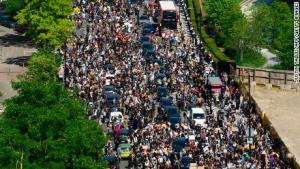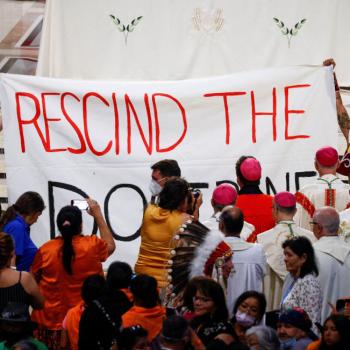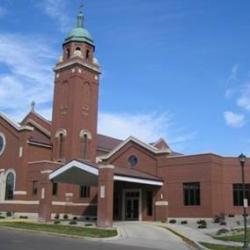
The dangerous use of analogy over protest marches
People often resort to the literary technique of analogy when arguing about emotional issues. In fact, it’s unavoidable. Pure logic simply won’t do for the matters that are closest to the heart, like God, beauty, morality, politics and what we ought to hope for. To my elementary school students I taught what I had learned in college classes, namely, that these are all matters of opinion. I had learned wrong and was teaching wrong. There is truth in all these matters of the heart, even if it’s hard to get at with straight logic. Analogy is one technique people often use.
I’m still thinking, as in the last two posts, about the murder of George Floyd in Minneapolis and the protests that followed. So are many others, and the use of analogy is thriving, at least on social media. Not always in ways that help the conversation along. Here I give two examples of using analogy in politics. In one I try to use the technique correctly.
A man throws a boy off the third-floor balcony at Mall of America
This analogy finds, as one supposes, an inconsistency between two instances of black versus white conflict:
Remember when a black career criminal threw a 5-year-old white boy off the third floor balcony in Minnesota’s Mall of America?
Me too.
Remember the race riots?
Me neither.
(The boy survived, miraculously according to his parents. You can find the legal resolution of this case here.)
David Tracy has been my main blog interest lately and will be for a while. One of his big concepts is what he calls “the Catholic analogical imagination.” Analogy plays a key role in Tracy’s thought, but he doesn’t shy away from ordinary logic. In fact, he says, while theological reasoning may go beyond logic, it must be at least logically coherent.
I didn’t realize how important that seemingly obvious reminder is until someone on social media tried to use a black-on-white attempted murder as an analogy for the murder of a black man by a white police officer. The two are analogous, but to think that protests and riots should follow one if they follow the other is to operate with a faulty definition of political protest. That’s a logical failure. In the Mall of America case there was no real political issue to protest about.
Armed protestors violate lockdown order at Michigan State Capitol
Here’s another analogy. The data comes from Slate News. Two groups violate a law, both engaging in a political protest:
- An armed group of white men march into a state Capitol. (North Carolina and Michigan are two of several where this took place.) Members come within inches of the faces of police standing by, violating a lockdown regulation and social distancing rules. Police, responding only with calm discipline, make no effort to push the men back or clear the space. In Michigan lawmakers decide to close the session so as not to risk violence, aware of death threats against Governor Gretchen Whitmer.
- Last Saturday evening a mixed-race group of unarmed men and women marched through the streets of Minneapolis in violation of a curfew. Everything was peaceful. Suddenly police and national guard arrived and pushed the crowd back with teargas, flash bangs, and rubber bullets. Many protesters were arrested.
There are similarities and differences. Both groups are protesters. One protests against the orders which they are presently violating—lockdown and social distancing. The other protests a longstanding pattern of police action culminating in the recent murder of George Floyd. The biggest difference is in the reaction of law enforcement.
Using the analogy
I’d like to draw some conclusions from this analogy, but it’s tricky. Can I conclude that police should have acted in Minneapolis as they did in Michigan and North Carolina? Or vice versa? Or maybe that white people, but not people of color can get away with violating laws in this unjust world? Actually, while I endorse that last thought, this analogy doesn’t prove it. I believe law enforcement acted properly in both instances. They didn’t make martyrs out of a bunch of ridiculous men in the first, and they countered the violence of previous nights in the second.
One legitimate conclusion is obvious and quite easy to draw since it concerns only what is evident in the different scenes themselves. The peaceful people marching through the streets of Minneapolis were a whole lot braver than the gun-toters at the state capitols. Even if you know nothing about or have no opinion on the respective causes, you naturally respect the marchers in Minneapolis more than the others. Because of that respect, you want to lend an open mind to the cause of racial justice—exactly the result that the marchers want.
Martyrs like Jesus
I like to think of the arrests on that Saturday night in Minneapolis as a kind of martyrdom. It was even more obvious the following night when hundreds of protesters offered themselves peacefully and even joyfully to the arresting officers. They were practicing civil disobedience in the classic style, fully accepting the consequences of their actions.
Those consequences were not much like the consequence that Jesus faced. But the people were like Jesus in their willing acceptance and submission to the law’s demand, even if the whole system in both cases is unjust. Another way they were like Jesus isn’t often remarked upon, but Jesus, like them, practiced civil disobedience. Certainly that was his deliberate intention when he went into the Temple area and made a small ruckus. The action couldn’t have been much more than symbolic given the huge size of that pre-paschal market. I tend to think Jesus was deliberately flouting Sabbath rules also with many of his healings on the day of no work. It wouldn’t have hurt much to have waited till the next day.
But Jesus wasn’t dealing just with isolated incidents of disease, hunger, and possession. The evil Jesus faced was the sin of the world. That sin was festering not just in the minds of individuals, though there were individual bad guys. It existed most powerfully in the unjust systems that controlled that world. The system was responsible for much of the disease, hunger, and poverty of that world. Even the phenomenon of demonic possession (according to some anthropologists) can be an unconscious reaction to being under the thumb (possessed by) an unjust system.
In this way also the marchers in Minneapolis were like Jesus, fighting against an unjust system, one present-day example of the “sin of the world.”
Final note
Along this same line, Minnesota governor Tim Walz made a perceptive comment during a briefing on Monday. He said we are not dealing with a broken system. In the case of George Floyd, the system operated exactly as designed. It’s our job to change the design of that system.
Image credit: Cable News Network











